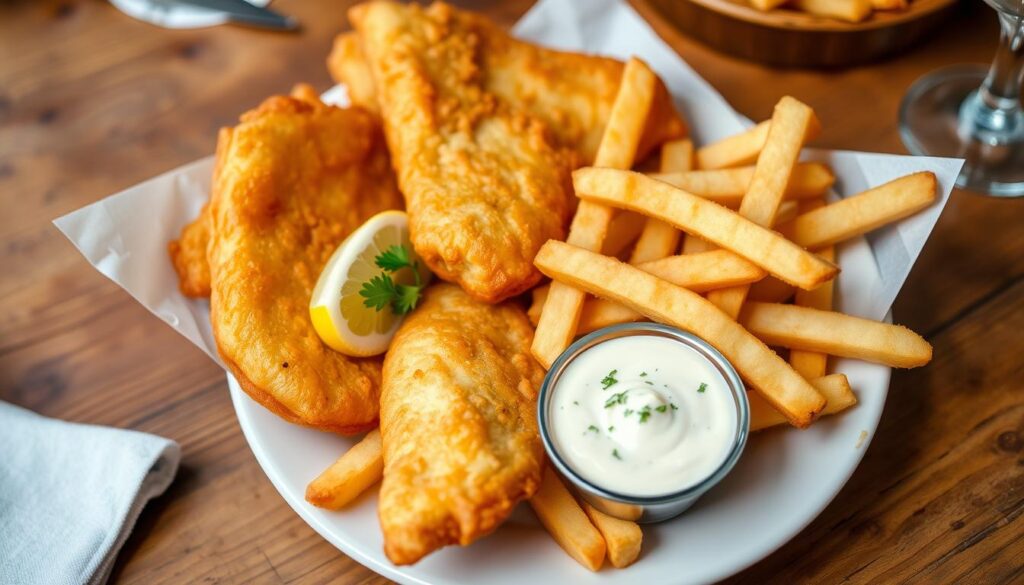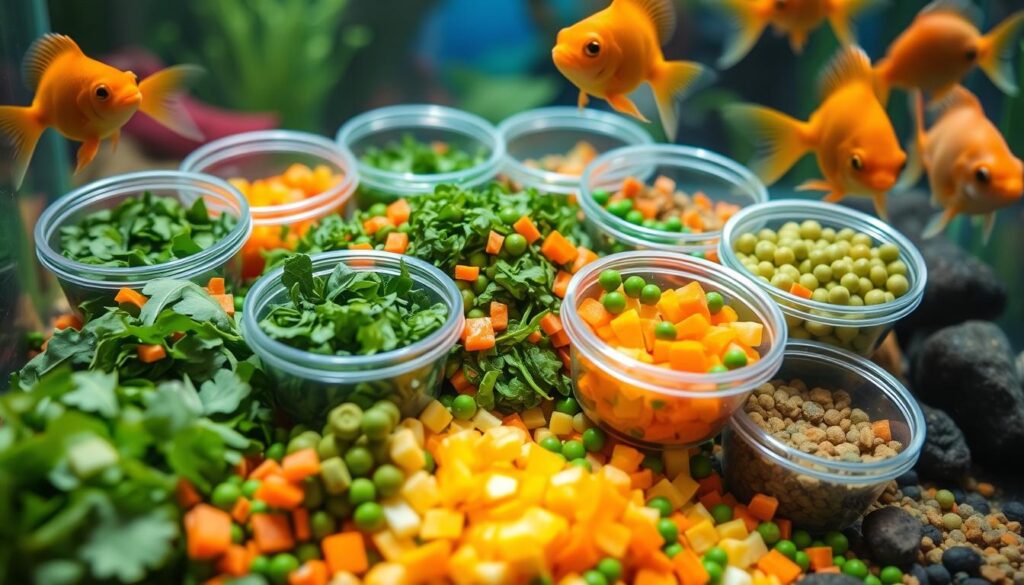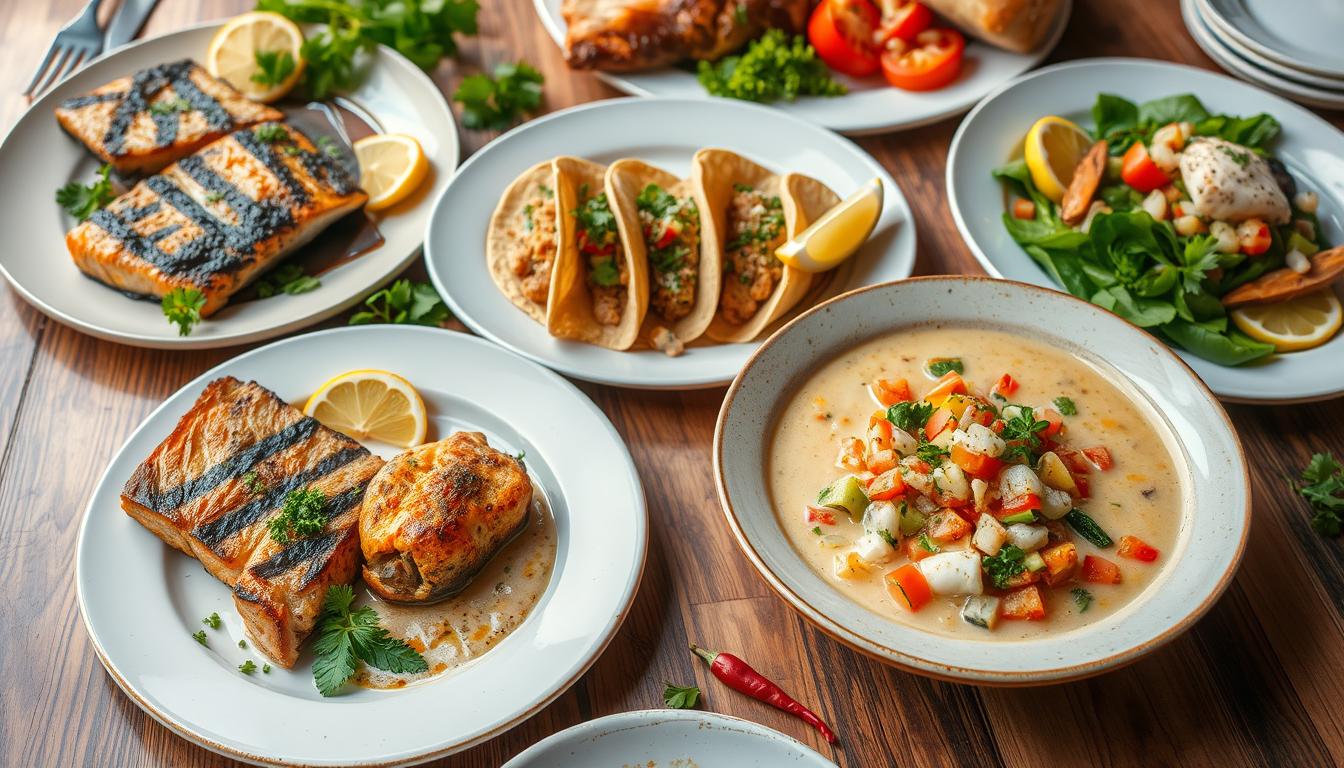Ever stared into your kitchen, wondering how to turn fresh fish fillets into something amazing? Cooking fish doesn’t have to be scary. These homemade fish food recipes will change your weeknight dinners, making seafood meals as good as those from restaurants in just minutes.
Our collection includes everything from juicy salmon to crispy tilapia. It covers a wide range of flavors and cooking methods. Whether you’re an experienced cook or new to seafood, these recipes will encourage you to try new things in fish cooking.
Prepare for a culinary journey that’s quick, healthy, and delicious. These fish food recipes are made to be easy, nutritious, and very tasty.
Key Takeaways
- Discover 10 versatile fish recipes with preparation times ranging from 6 to 45 minutes
- Learn multiple cooking techniques including baking, grilling, and pan-frying
- Explore recipes featuring salmon, tilapia, tuna, and other popular fish varieties
- Incorporate fresh herbs and vegetables for enhanced flavor and nutrition
- Master quick and easy seafood meal preparation for busy weeknights
Understanding the Basics of Homemade Fish Food
Making fish food at home is rewarding. It ensures your fish get the best nutrition. To start, learn about your fish’s nutritional needs and the perks of making their food.
Fish nutrition is more than just feeding them. They need a balanced diet to stay healthy. Making their food at home lets you tailor their nutrition.
Essential Nutrients for Fish Health
Every fish needs different nutrients, but some are the same:
- Protein (55% by dry weight for optimal growth)
- Fats (10-15% for juvenile fish development)
- Vitamins and minerals
- Omega-3 fatty acids
Benefits of Making Your Own Fish Food
Homemade fish food offers many benefits:
- You control the quality of ingredients.
- You can tailor the food for your fish’s needs.
- You avoid preservatives found in store-bought food.
- It might save you money in the long run.
Required Kitchen Equipment
| Equipment | Purpose |
|---|---|
| Food processor | Grinding ingredients |
| Mixing bowls | Combining ingredients |
| Gelatin | Creating food binding |
| Measuring cups | Precise ingredient portions |
“Nutrition is the foundation of fish health, and homemade food offers unparalleled control and quality.” – Aquarium Nutrition Expert
Remember, each fish species has unique nutritional needs, so research is key when preparing homemade fish food.
Mediterranean-Style Baked Tilapia
Explore a new fish food recipe that turns your weeknight dinner into a Mediterranean feast. This baked tilapia dish brings the Mediterranean’s lively flavors to your home. It’s a healthy, tasty meal that’s easy to make.
“Fresh ingredients and simple techniques create extraordinary meals” – Mediterranean Cooking Wisdom
Tilapia, a mild and sweet fish, is perfect for this dish. It comes from Peru, Ecuador, and Mexico. This fish is a great protein choice for your recipes.
Key Ingredients
- Fresh tilapia fillets
- Cherry tomatoes
- Shallot and garlic
- Fresh herbs (thyme, basil, parsley)
- Olive oil
- Lemon
- Feta cheese (optional)
Cooking Highlights
Preparing your baked tilapia is simple. Just preheat your oven to 400℉. You’ll have a delicious meal in 25 minutes. It’s pescatarian, gluten-free, and can be dairy-free without feta cheese.
| Nutritional Information | Per Serving |
|---|---|
| Calories | 378 |
| Protein | 4g |
| Carbohydrates | 22g |
| Fat | 33g |
Pro tip: Let your baked tilapia rest for 5 minutes after cooking. This ensures it’s full of flavor and tender. Serve it with sautéed veggies, whole grains, or a crisp salad for a full Mediterranean meal.
Cooking Tips
- Thaw fish completely before baking
- Use fresh herbs for maximum flavor
- Check fish doneness at 15 minutes
- Experiment with different seasonings
This baked tilapia recipe has a 4.9 out of 5 rating from 23 reviews. It’s a must-have in your fish food recipes collection!
Citrus-Glazed Salmon with Fresh Herbs
Make your salmon dishes special with this tasty citrus-glazed fish. It’s like having a restaurant meal at home. To make a great salmon dish, pay attention to details and use a few important techniques.
Selecting the Perfect Salmon Fillet
Choosing the right salmon fillet is key. Look for these qualities:
- Fresh, bright colored salmon with a firm texture
- Wild-caught salmon for richer flavor
- 1.5-2 lbs of salmon, cut into four individual fillets
- Fillets should be the same thickness for even cooking
Preparing the Citrus Glaze
For a great citrus-glazed fish, mix the right ingredients. Your glaze will have:
- 1/4 cup fresh orange juice
- 2 tablespoons honey
- 1 tablespoon Dijon mustard
- Orange and lemon zest for bright citrus notes
- Minced fresh garlic for depth
Cooking Temperature Guidelines
When cooking citrus-glazed fish, be precise. Follow these temperature tips:
- Preheat oven to 375°F
- Bake salmon for 18-20 minutes
- Internal temperature should reach 145°F
- Let rest for 3-5 minutes after cooking
“The secret to perfect salmon is respecting its delicate nature and allowing its natural flavors to shine through.”
This salmon recipe is not only tasty but also healthy. It has 362 calories per serving, with 35g of protein. Serve it with steamed rice and garnish with fresh orange slices for a complete meal.
Crispy Fish and Chips with Homemade Tartar Sauce

Make the classic British pub favorite in your kitchen with this fish and chips recipe. It’s perfect for a Friday night treat or to impress your family. This homemade version will make your seafood cravings disappear.
Choosing the right fish is key for a great fish and chips. Cod is the top pick for its delicate texture and crispy coating. Haddock, tilapia, and halibut are also excellent choices.
Ingredients for Crispy Fish
- 4 white fish fillets (preferably cod)
- 1 cup panko breadcrumbs
- 1 tablespoon baking powder
- Salt and pepper to taste
- Neutral oil for frying
Homemade Tartar Sauce Ingredients
- 1/2 cup mayonnaise
- 2 tablespoons chopped pickles
- 1 tablespoon capers
- 1 teaspoon fresh dill
- Lemon juice to taste
The secret to crispy fish and chips is in the prep. Dry the fish, coat with panko breadcrumbs, and heat the oil to 350-375 degrees Fahrenheit. Fry each piece for about a minute on each side until golden brown.
“The key to perfect fish and chips is maintaining the right oil temperature and ensuring a crisp, even coating.” – Culinary Expert
To make the homemade tartar sauce, mix all ingredients and let it sit for 30 minutes before serving. This lets the flavors blend, making a tasty side for your crispy fish.
Pro Tips for Perfect Results
- Always use fresh fish for the best flavor
- Press panko firmly onto the fish for maximum crispiness
- Prepare tartar sauce in advance for deeper flavor
- Serve immediately for maximum crunchiness
Your homemade tartar sauce will be fresher and cheaper than store-bought. Plus, you can adjust the flavors to your liking.
Spicy Fish Food Recipes for Tropical Species
Tropical fish lovers know how key it is to feed their pets tasty, nutritious meals. Spicy fish recipes can make your tropical fish food exciting, adding flavor and important nutrients.
Making homemade spicy fish food means thinking about what your fish needs. Tropical fish do best on varied, protein-rich diets. These diets keep them healthy and happy.
Hot Pepper and Garlic Mix
A tasty spicy fish food recipe might include:
- Fresh garlic (minced)
- Dried red pepper flakes
- Ground fish meal
- Spirulina powder
Protein-Rich Spicy Blend
Your tropical fish will enjoy this spicy, protein-rich mix. It’s packed with nutrients they need:
| Ingredient | Nutritional Value | Quantity |
|---|---|---|
| Shrimp meal | High protein | 40% |
| Chili powder | Metabolism booster | 5% |
| Fish oil | Omega-3 fatty acids | 10% |
“Nutrition is the key to vibrant, healthy tropical fish.” – Aquarium Experts
When making spicy fish recipes, mix heat with nutrition. Start with a little spice and add more until it’s just right for your fish.
Goldfish Special: Vegetable-Based Food Mix

Creating a nutritious homemade fish food for goldfish is key. They have a special digestive system. This makes vegetable-based food a great choice.
When making homemade fish food for goldfish, use these vegetables:
- Spinach: Rich in essential nutrients
- Sweet potato: Provides complex carbohydrates
- Cucumber: Hydrating and easily digestible
- Kale: Packed with vitamins
Goldfish don’t have a stomach. This means they digest food differently. So, picking the right ingredients is very important.
“Nutrition is the foundation of goldfish health and vibrant color.” – Aquarium Nutrition Expert
Here’s a simple recipe for vegetable-based goldfish food:
| Ingredient | Quantity | Nutritional Benefit |
|---|---|---|
| Spinach | 30% | Minerals and vitamins |
| Sweet Potato | 25% | Complex carbohydrates |
| Gelatin | 20% | Binding agent |
| Brine Shrimp | 25% | Protein source |
Pro tip: Feed your goldfish as much as they can eat in 2-3 minutes. This prevents overfeeding and keeps the water clean.
Protein-Packed Pellets for Pond Fish
Making fish food for pond fish at home is fun and rewarding. It lets you give your fish nutritious, tailored meals.
Creating protein-rich pellets needs careful thought about ingredients and how to prepare them. Your pond fish need a balanced diet to stay healthy and full of energy.
Selecting Protein Sources
Choosing the right protein is key when making fish food pellets. Here are some top picks:
- Spirulina algae (60% protein content)
- Brine shrimp
- Fish meal
- Wheat germ
Forming and Drying Methods
Getting the right pellet shape is important. Here’s how to make consistent, durable pellets:
- Blend protein sources into a fine mix
- Add gelatin as a binder
- Make small, uniform pellets
- Dry them in air or a low-temperature oven
Storage Tips
Keeping your homemade fish food fresh is crucial. Store it in an airtight container in a cool, dry spot. Refrigeration can keep it fresh for up to 3 months.
“Quality nutrition is the key to healthy, vibrant pond fish.” – Aquaculture Expert
| Protein Source | Protein Percentage | Benefits |
|---|---|---|
| Spirulina | 60% | Boosts immune system, enhances coloration |
| Brine Shrimp | 55% | High protein, excellent for young fish |
| Fish Meal | 65% | Complete amino acid profile |
Remember to adjust feeding frequency based on water temperature and your specific pond fish species.
Quick and Easy Flake Food Recipe
Making fish food flakes at home is rewarding for aquarium fans. This simple recipe helps you make healthy flakes for your fish.
To make fish food flakes, you need a few ingredients and basic tools. First, gather these key items:
- High-quality protein source (fish meal or shrimp)
- Vegetables for added nutrition
- Binding agent (gelatin or egg)
- Nutritional supplements
- Food processor or blender
- Baking sheet
Pro tip: The key to great homemade fish food flakes is finding the right balance of nutrients for your specific fish species.
“Crafting your own fish food allows you to control exactly what goes into your aquarium ecosystem.” – Marine Biology Expert
To make your flakes, follow these easy steps:
- Blend protein source with vegetables
- Add binding agent and supplements
- Spread mixture thinly on a baking sheet
- Dry in oven at low temperature (around 200°F)
- Break into small flakes once completely dry
This DIY fish food ensures your fish get fresh, balanced meals. It’s tailored to their needs.
Natural Food Alternatives for Saltwater Fish
Creating homemade saltwater fish food means knowing what your marine friends need. They need a diet that’s close to their natural home. Choosing the right ingredients is key to keeping your fish healthy.
Natural food options are great for saltwater aquarium fans:
- They give essential nutrients from the sea
- They help fish look their best colors
- They boost fish health
- They cut down on store-bought foods
Marine proteins are vital for a balanced homemade diet. Here are some natural choices:
- Fresh marine shrimp
- Squid pieces
- Krill
- Seaweed extracts
“The ocean provides the most nutritious ingredients for saltwater fish nutrition.” – Marine Biologist Research Team
Knowing how marine ecosystems work helps make better food for your fish. Sadly, over 34% of the world’s fish are caught too much. This makes making food sustainably very important for caring for your aquarium.
| Ingredient | Nutritional Value | Benefits |
|---|---|---|
| Fresh Krill | High Protein | Supports Growth |
| Marine Algae | Rich in Minerals | Enhances Immunity |
| Squid | Complete Protein | Muscle Development |
Professional tip: Always get your ingredients from trusted marine suppliers for the best nutrition for your fish.
Seasonal Fish Food Variations
Making the right seasonal fish food is an art that boosts your fish’s health and energy. Fish need different nutrients at different times of the year. This is why seasonal fish food is key for their well-being.
Learning to adjust your fish food recipes with the seasons is vital. It helps your fish stay healthy and strong. The right food supports their immune system and energy levels.
Summer Blend Recipes
In summer, fish need light, easy-to-digest food to handle the heat. Your seasonal fish food should include:
- High-protein ingredients for quick energy
- Ingredients with cooling properties
- Nutrient-dense foods for metabolism support
Pro tip: Add veggies like cucumber and zucchini to keep fish hydrated and cool in the heat.
Winter Nutrient Boosters
Winter fish food needs to be more filling and packed with nutrients. This helps keep their body temperature up and boosts their immune system. Look for these key elements:
- Higher fat content for energy
- Protein-rich ingredients for metabolism
- Ingredients that boost immune system resilience
“Adapting your fish food to seasonal changes is not just about nutrition, it’s about survival and thriving.” – Aquatic Nutrition Expert
By adjusting your fish food with the seasons, you can give your aquatic pets the best nutrition all year.
Conclusion
Making homemade fish food is more than cooking—it’s about giving your fish the best nutrition. This guide showed you many recipes that are better than store-bought food. You learned how to make everything from tilapia to pond fish pellets.
Homemade fish food saves money and lets you control what your fish eat. You can make meals for tropical fish or goldfish that they love. This way, you make sure your fish get the right food for their needs.
Trying new things is important when making fish food. Mix proteins, add veggies, and change the recipe to keep your fish happy. Soon, you’ll make food that keeps your fish healthy and full of energy.
Learning about fish food is a never-ending journey. Keep looking for new ideas and enjoy making food for your fish. Your hard work will make your fish happy and healthy.

